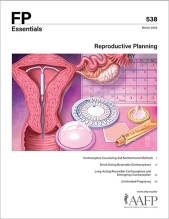
This clinical content conforms to AAFP criteria for CME.
Long-acting reversible contraceptives (LARCs) include progestin and copper intrauterine devices (IUDs) and progestin subdermal implants. LARCs may be the preferred for individuals who want a method that is highly effective and can last for several years, or for whom estrogen is contraindicated. LARCs should be offered using a shared decision-making approach, keeping in mind that historically these methods have been used coercively to control the reproductive choices of marginalized or disabled people. To ensure safe prescribing and reduce barriers to receiving LARCs, family physicians should be familiar with two evidence-based national contraceptive guidelines: the U.S. Medical Eligibility Criteria for Contraceptive Use (U.S. MEC) and the U.S. Selected Practice Recommendations for Contraceptive Use (U.S. SPR). Information about insertion, removal, potential complications, and expected adverse effects should be included when counseling patients about LARC options. Both types of LARC IUDs can safely be used for emergency contraception if inserted within 5 days of unprotected intercourse. Several oral emergency contraception drug options also are available.
Case 3. EM is 40-year-old patient who returns to your office after receiving her first etonogestrel subdermal implant 10 weeks ago. She reports she has not had any break from vaginal bleeding for the past 8 weeks. She is frustrated and wants to know what to do.
Long-acting reversible contraceptives (LARCs) include several intrauterine devices (IUDs) and a subdermal implant; these methods have failure rates of less than 1% (Figure 1).27 In addition, these methods do not require daily, monthly, or quarterly action from their users. Approximately 16% of all US contraceptive users ages 15 to 49 years rely on LARCs.
Subscribe
From $350- Immediate, unlimited access to FP Essentials content
- 60 CME credits/year
- AAFP app access
- Print delivery available
Edition Access
$44- Immediate, unlimited access to this edition's content
- 5 CME credits
- AAFP app access
- Print delivery available
